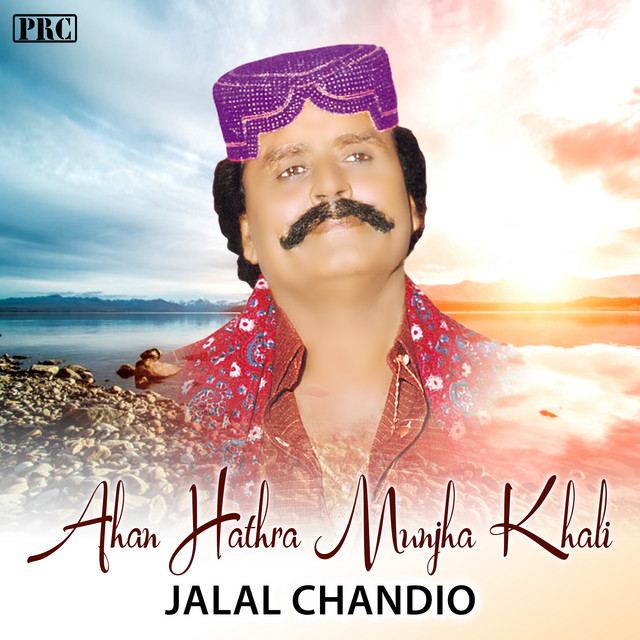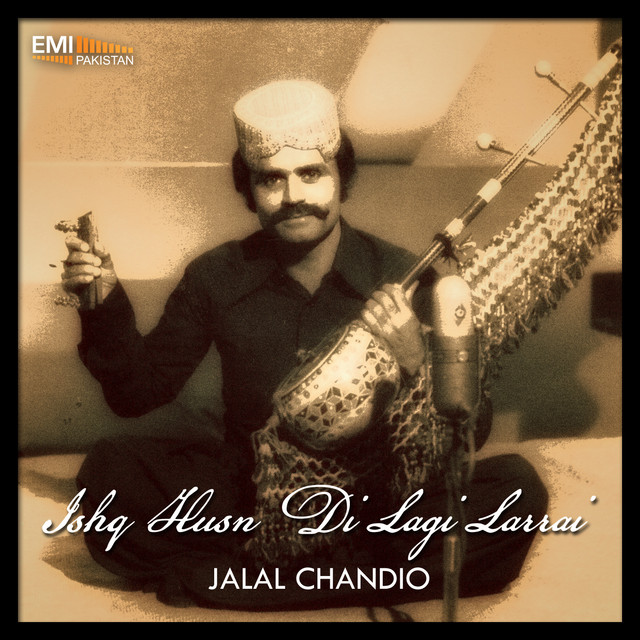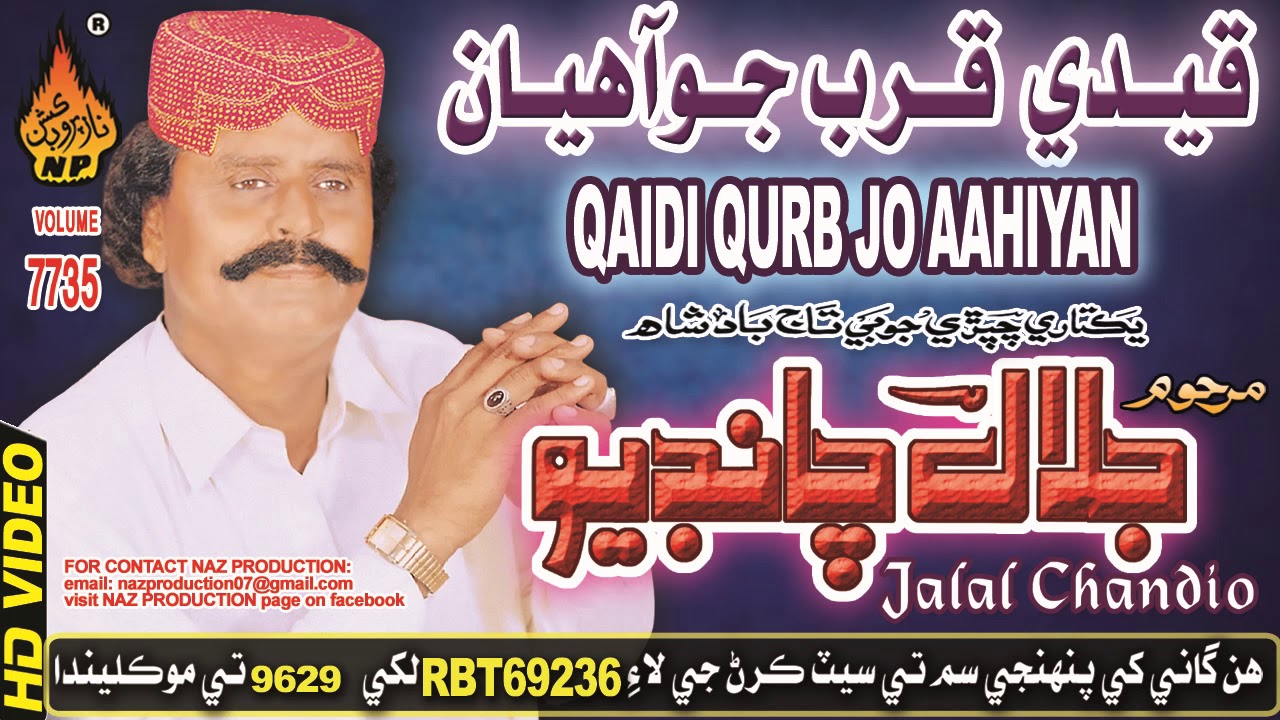
Jalal Chandio, who passed away on Jan.10, 2001, sang the works of rural poets which were representative of our indigenous culture. His music played an important role in the preservation and promotion of the Sufi poetic heritage.
By Rafique Wassan
Music in Sindh displays diverse forms, trends and styles of performance, instruments, context, content and repertoire. It also embraces various song styles, musician families and traditions such as ceremonial, classical, semi-classical, folk and Sufi music schools. There are thus many singers, musicians and instrumentalists associated with these particular styles and forms.
Some musicians, being incredibly popular owing to their distinctive contribution and charisma, have created a massive following, in the process themselves becoming folk heroes and icons of Sindhi music.
With his distinct style of musical performance, Jalal Chandio has been a prominent folk singer among the rural masses of Sindh for over four decades. He contributed to and popularized the peculiar tradition and style of singing by using the Yaktaaro (rod-like one-string instrument) and Chappryun (hand clappers), a style that was already popular at Sufi Shrines. Chandio further developed this style and introduced it to the genre of folk music.
 Born in 1944 in a village near Moro town of District Naushahro Feroze, Jalal Chandio was inclined towards music since his early age. His father sent him to learn tailoring, but young Chandio’s soul drove him towards singing. He would listen to songs on the radio and visit the annual festivals held at saints’ shrines, an integral part of rural Sindhi society and culture.
Born in 1944 in a village near Moro town of District Naushahro Feroze, Jalal Chandio was inclined towards music since his early age. His father sent him to learn tailoring, but young Chandio’s soul drove him towards singing. He would listen to songs on the radio and visit the annual festivals held at saints’ shrines, an integral part of rural Sindhi society and culture.
During the ’70s, Jalal Chandio debuted as a novice singer, soon becoming popular with his vocal style, performance, selection of expressive poetry, narration of romance and use of instruments that later became associated with him. With his powerful voice and poetic expressions, he became a trend-setter in Sindhi folk music. He introduced the concept and trend of Farmaish — a peculiar style of narrating the names of listeners as they listened to their names in his songs — thus reciprocating, and garnering even more appreciation.
Previously, the rural population used to listen to Indian film music and Pakistani Punjabi singers such as Madam Noor Jehan and Inayat Husain Bhatti but with his rise in popularity, Chandio’s songs were played on tractors and trucks, providing entertainment and relief for laborers with long and hectic work schedules.
Chandio would be invited to sing at weddings and other festive occasions. His performances at the grand annual festivals of saints’ shrines such as Shah Abdul Latif Bhitai, Sachal Sarmast, Saman Sarkar, Ranipur and Khairpur Nathan Shah would attract large audiences.
In the ’80s, Paras, a music recording company in Hyderabad became the brand name for Jalal’s audio albums and the sale of his tapes led to a historic sale of Sanyo and National tape recorders in rural Sindh.
A large number of new singers who were influenced by Jalal Chandio’s musical style emerged, many of them being Chandio’s shagirds (students). Rubina Hyderi and Taj Mastani, two popular folk female Sindhi singers also adopted Jalal’s style of Yaktaaro and Chappryun. His popularity spread to Seraiki districts in Punjab and the border districts of Balochistan.
Jalal Chandio sang the works of rural poets which were representative of our indigenous culture. His music played an important role in the preservation and promotion of the Sufi poetic heritage as he rendered the mystic kalaam of Shah Abdul Latif Bhittai, Sachal Sarmast, Khawaja Ghulam Fareed, Bulleh Shah and many other Sufi poets. During the peak of Sindhi nationalism in the ’80s, Jalal sang nationalist songs too.
 Jalal Chandio passed away on Jan 10, 2001 in a hospital in Karachi. Jalal’s folk music tradition and style is symbolic to love, romance and rebellion; his legacy and heritage offer rich cultural context for students and ethno-musicologists. The rural landscape of Sindh is incomplete without Jalal Chandio’s images on trucks and his ever-popular music and songs playing in the fields, tractors, eating places and homes.
Jalal Chandio passed away on Jan 10, 2001 in a hospital in Karachi. Jalal’s folk music tradition and style is symbolic to love, romance and rebellion; his legacy and heritage offer rich cultural context for students and ethno-musicologists. The rural landscape of Sindh is incomplete without Jalal Chandio’s images on trucks and his ever-popular music and songs playing in the fields, tractors, eating places and homes.
Although, Jalal Chandio was one of the few singers who had a lot of contribution in popularizing the folk and mystic music, but unfortunately, he couldn’t get recognition from the literary and cultural circles and organizations, and was rather neglected by them.
Being an anthropologist researcher, I had been deeply interested in Sindhi Sufi music heritage. When I started working on Sindh’s Sufi heritage as part of my doctoral research, the first thing that attracted me a lot, was the mystic songs and poetry, being the most powerful popular cultural aspect of Sufi heritage of Sindh. During my research, I minutely examined the contribution of popular singers and I found that Jalal Chandio’s contribution was much more than others.
Generally, Jalal Chandio was considered as a singer who mainly sang just romantic Kalams, but a great part of Sufi songs sung by him remained unnoticed or was deliberately neglected by the mainstream literary establishment and government organizations. The fact is that Jalal Chandio beautifully sang and preserved a lot of Sufi Kalams and preserved this mystic treasure from very beginning and continued till last. He was a distinguished singer whose popular style of singing had a very prominent Sufi color, as he used to select mostly the Sufi Kalams. This can be judged from the fact that beside Shah Abdul Latif Bhittai and Sachal Sarmast, he also sung the Kalams of a large number of popular Sufi poets like Bedil Fakir, Budhal Fakir, Rakhiyal Shah, Cheezal Shah, Muhammad Fakir Khatiyan, Fakir Mehdi Saeen, Jan’an Fakir, Aijaz Saeen, Razi Fakir, Reejhal Shah, Gohar Shah, Sufi Sadi Shah, Umdal Fakir, Wariyal Fakir Abro and several others.
Many years back, I had a chance to listen to Shafi Fakir at a musical concert at the annual festival of Shah Inayat Shaheed. He sang Sufi Sadiqq Shah’s Kalam:
آئون اھوئي آھيان، جو ڪُٺو تو ڪلھه
Very interestingly, during my research, I found the same Kalam sung by Jalal Chandio from one of his cassettes of 1980s. What a beautiful and mesmerizing style of singing he had. There are lots of other Sufi Kalams, which he sung and preserved for the generations to come. A few of such Kalams are Reejhal Shah’s Kalam from Sur Mumal Rano:
فقط تنھنجي اچڻ جي ديرآ، کلي آ برھه جي بازار
Fakir Mehdi Saeen’s Kalam:
اول سر جو سانگو لاھ ڀلي پوءِ عشق کي ھٿڙو لاِءِ
And Baba Bulleh Shah’s Kalam:
وسر ڳئي سڀ خيال اساڏي،
ڪيا مسيتان نال اساڏا
Jalal Chandio has preserved all this treasure, which no other folk artist could have done.
Very recently, I came across an Indian American friend who is working on a project of digitalization of South Asian Music. I suggested her to include some of the selected popular songs of Jalal Chandio in her project, which she agreed. This suggestion was based on my observation that the popular Sindhi singers and their treasure of songs are missing from the well-organized digital archives. Even the songs available on YouTube are not of good quality as far as presentation is concerned. It’s therefore direly needed to raise the standard of songs sung by Sindhi folk and popular singers using the global digital and new media technology, so that this treasure and heritage could be preserved and presented at any forum for our cultural identity. Sindh Culture Department can play a pivotal role in this regard. It’s my humble suggestion to the people sitting at the helms of affairs in culture department to save the Sufi songs sung by Jalal Chandio and other folk singers in digital media archives. This would not only preserve the Sindhi Cultural and Sufi heritage but also would help international researchers and scholars to work on our cultural heritage.
I have shared a few links of Sufi Kalams sung by Jalal Chandio.
Click here to listen to Sufi songs sung by Jalal Chandio
Sufi Kalam of Fakir Janan Chan
Moomal Rano
Siraiki Song
Siraiki Song
Another Sufi Song
[author title=”Rafique Wassan ” image=”https://sindhcourier.com/wp-content/uploads/2021/11/Rafique-Wassan-Sindh-Courier.jpg”]Writer is anthropologist and teaches at the Department of Anthropology and Archaeology, University of Sindh, Jamshoro, Pakistan[/author]